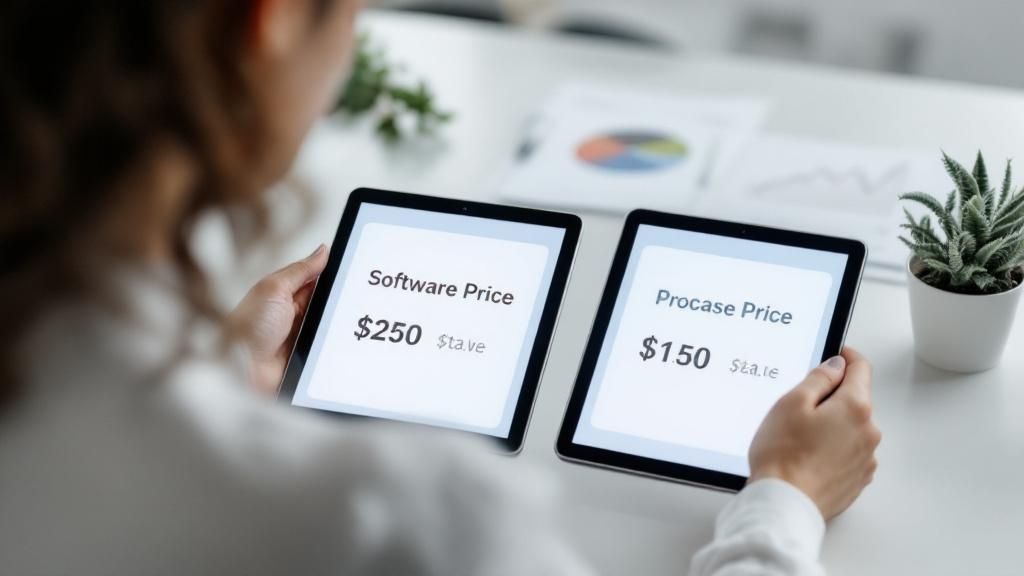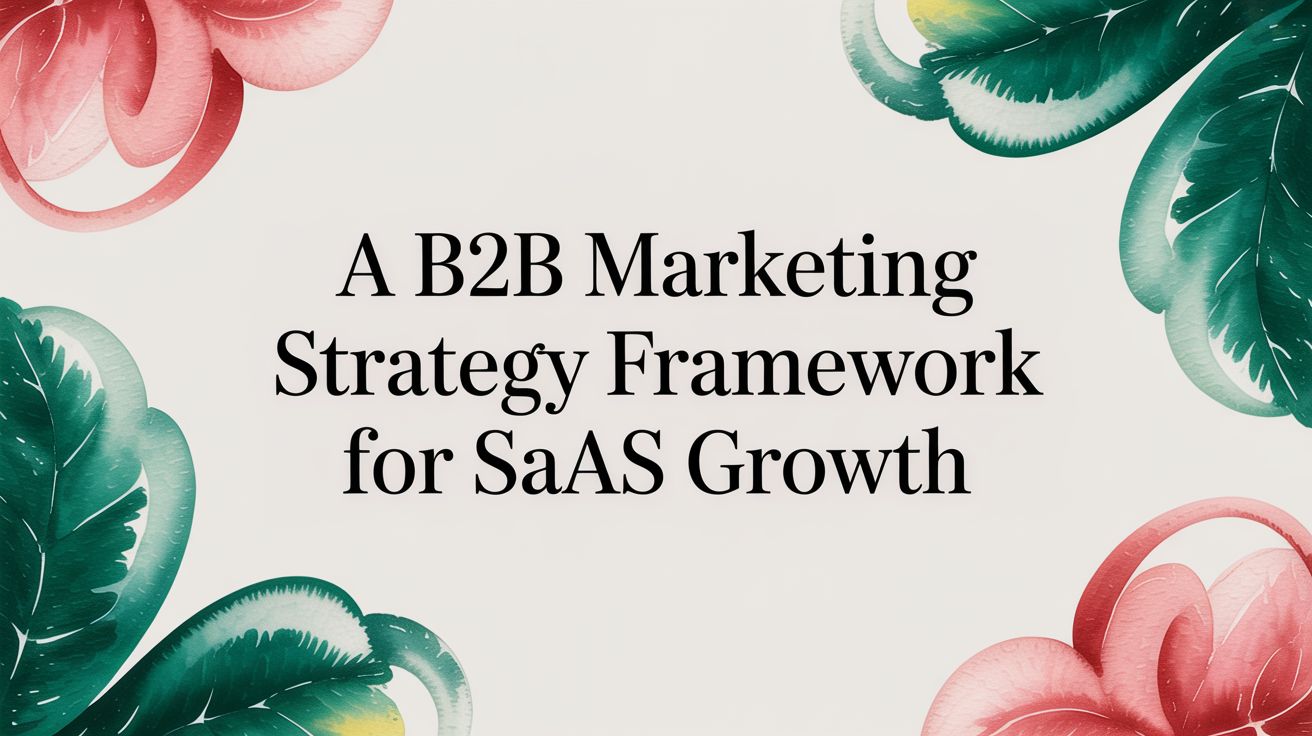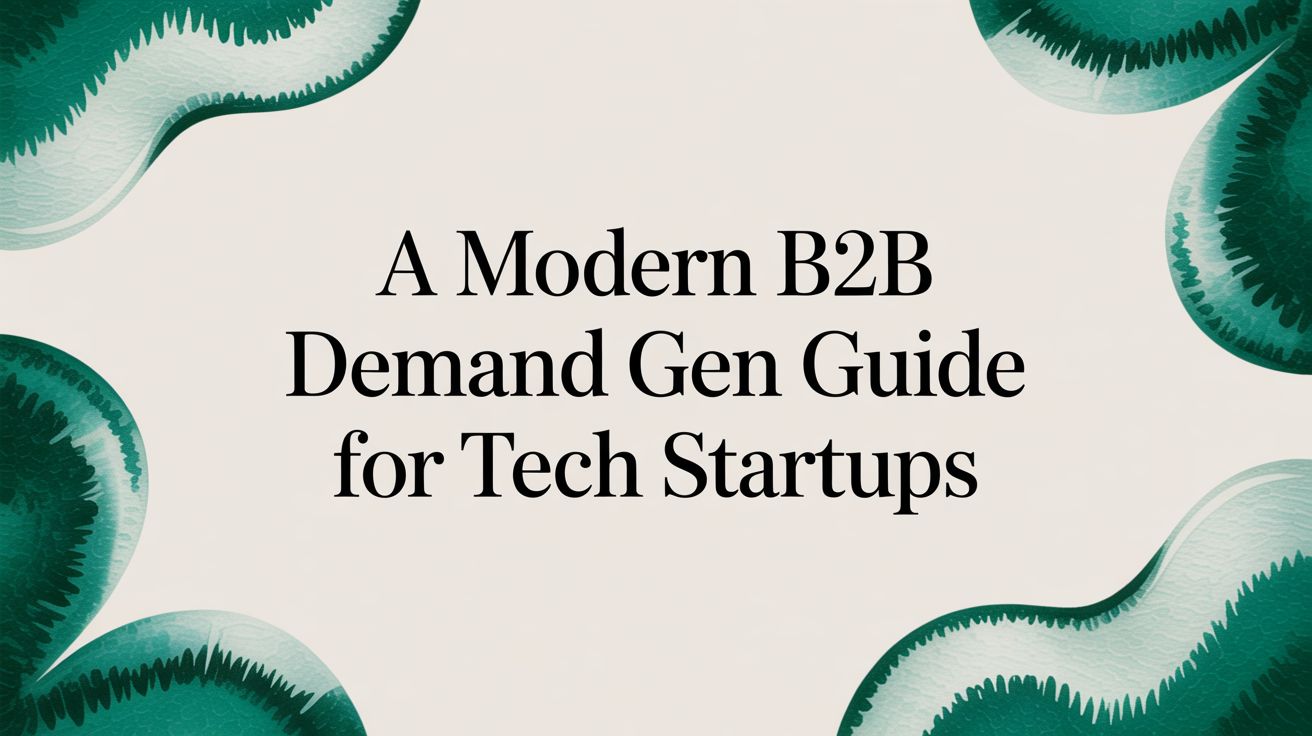Software Pricing Strategies That Drive Revenue Growth
June 24, 2025

Why Your Software Pricing Strategy Makes or Breaks Revenue
Imagine your B2B software company as a high-performance vehicle. The product is your chassis, marketing provides the slick paint job, and your team is the expert pit crew. But what powers the whole operation? The engine. Your software pricing strategy is that engine. If it’s weak or badly designed, even the most stunning car will sputter and stall right at the starting line.
Too many founders treat pricing as a last-minute detail—just a number to slap on before launch. In reality, it's the core mechanism that drives your revenue and determines if your business will be around for the long haul. Getting it right isn't just a good idea; it's fundamental to your survival and growth.
Pricing: The Silent Communicator of Value
The price you put on your software is one of the first and most powerful signals you send to potential customers. A low price might catch some eyes, but it can also scream a lack of confidence or a less capable solution. This often attracts customers who are quick to churn when something better or cheaper comes along.
On the other hand, a premium price signals confidence and high value. However, you must back it up with a product that delivers clear, measurable results for your B2B clients. This is why an old-school cost-plus approach—calculating your expenses and adding a markup—is so out of place in the software world.
This method completely ignores the most important factor: the value your customer receives. Your development costs don’t matter to a client who’s trying to solve a multi-million dollar problem. Their willingness to pay is directly tied to how much money you can make them, save them, or how much risk you can eliminate. This principle is at the heart of modern SaaS pricing, which you can explore in our detailed guide on the topic.
The Overlooked Growth Lever
Even with its critical role, pricing is often a "set it and forget it" part of the business. Companies decide on a price early on and rarely look at it again, leaving massive opportunities on the table. This is a significant blind spot. A June 2023 analysis from McKinsey found that only 49% of software executives had increased investment in their pricing teams over the past year.
This means more than half the market is potentially leaving money on the table by not treating pricing as the active, dynamic function it should be. You can see more details in the full software pricing report to better understand this industry trend.
Ultimately, your pricing model isn't just about collecting payments. It's a strategic choice that defines how you scale. The right model aligns your revenue directly with your customers' success, creating a true partnership where growth benefits everyone. To see a wider range of methods for structuring recurring revenue, you can check out these proven frameworks for subscription pricing strategies. As we’ll discuss, choosing the right framework is the first step toward building a resilient, high-growth software business.
Value-Based Pricing That Actually Works in B2B Software
Of all the software pricing strategies, value-based pricing is the most tuned to a customer's success, but it's often the most misunderstood. Instead of basing your price on your internal costs or what competitors charge, this model ties your software’s price directly to the measurable economic value it creates for the customer. Think of it less like selling a product and more like selling a tangible business outcome, such as increased revenue, saved operational hours, or reduced compliance risk.
For B2B companies, this approach shifts the sales conversation from "How much does this cost?" to "What return on investment can we expect?" It’s a powerful change. For instance, a marketing automation platform doesn't just sell email sends and landing pages; it sells the ability to generate qualified leads that turn into real revenue. If your software can demonstrably add $100,000 to a client's annual revenue, a $10,000 annual subscription suddenly looks like an incredible bargain.
Quantifying the Unquantifiable
The main challenge of value-based pricing is pinning down that "value." It requires a deep understanding of your customer's business and the ability to translate your features into concrete financial benefits. This process moves beyond feature lists and dives into the core problems your software solves.
Here’s how to start quantifying value:
- Identify Value Metrics: Work with your ideal customers to identify key performance indicators (KPIs) that your software directly impacts. This could be anything from reducing employee churn to accelerating the sales cycle.
- Conduct Value Discovery Calls: During sales conversations, ask questions that uncover financial pain points. How much time is wasted on manual data entry? What is the cost of a single compliance error? These answers become the foundation for your ROI calculation.
- Build Case Studies with Hard Numbers: Showcasing how you’ve helped similar companies achieve specific outcomes provides powerful proof. For example, "Company X reduced its customer acquisition cost by 25% within six months of implementation." Learning how to calculate customer acquisition cost is a crucial first step for many B2B teams looking to prove this kind of value.
The following infographic illustrates how the core components of value-based pricing work together.

This diagram shows that a successful strategy rests on understanding what customers are willing to pay, which is informed by their perceived value, and then structuring tiers that reflect that value.
Structuring Tiers Around Customer Outcomes
Once you understand the value you provide, you can structure your pricing tiers around it. Instead of basing tiers on the number of features, base them on the level of outcome a customer can achieve. For example, a CRM like Salesforce doesn't just offer more features at higher tiers; it offers solutions tailored to different business sizes and complexities—from a small sales team to a global enterprise.
A basic tier might be ideal for a company focused on organizing its sales process, delivering value through efficiency. In contrast, a premium tier might include advanced analytics and forecasting tools, delivering value through strategic insights that drive significant revenue growth.
To bring this to life, let’s compare how a traditional cost-plus approach differs from a value-based one. The table below outlines a practical framework for implementation.
This framework shows that value-based pricing is more than a calculation—it’s a complete shift in how you package, sell, and support your software. The focus moves from your internal costs to your customer's success metrics.
This structure makes the upgrade path a logical next step in the customer's growth journey, directly linking your revenue to their success. By adopting this mindset, you create a true partnership where you only win when your customers win.
Building Tiered Pricing That Guides Customers to Yes
Tiered pricing is one of the most common software pricing strategies for a good reason: when done right, it serves different types of customers while creating a clear path for them to grow with you. Think of it like a car dealership. They don’t just sell one model; they offer a base version, a well-equipped mid-range option, and a fully-loaded premium package. Each tier is built to match a specific buyer’s needs and budget, pointing them to the best fit.
The psychology behind this "good-better-best" method is surprisingly effective. It uses a behavioral science principle called price anchoring. By showing a higher-priced tier first, you create a reference point that makes the other options seem more reasonable. The idea isn't to sell the most expensive plan to everyone. Instead, it’s to make your target plan—often the middle one—feel like the most logical and valuable choice.
For B2B software, this means each tier should match a different stage of your customer's journey. A startup just getting its footing has very different needs than an enterprise team that requires advanced features and support.
Designing Tiers That Don’t Confuse
The secret to great tiered pricing is creating clear, meaningful differences between each plan. If the distinctions are too minor, potential customers get confused and either default to the cheapest option or walk away entirely. On the other hand, if the jump in features is too large, the upgrade path feels like an impossible leap.
Your tiers should be built around a primary value metric—the core unit of value your customer gets from your product. This is the "thing" they will use more of as their business grows.
A great way to structure this is to align tiers with customer goals:
- Basic Tier: Focuses on core features for small teams or companies solving an immediate, simple problem.
- Pro/Business Tier: Adds features that boost efficiency, help teams collaborate, and support growth. This is often your most popular and profitable tier.
- Enterprise Tier: Includes advanced security, dedicated support, and powerful analytics for large organizations with complex requirements.
For instance, a project management tool might limit the number of active projects in its basic tier, add automations and integrations in its pro tier, and provide enterprise-grade security and compliance tools in its top tier.
Tiered Pricing in Action
Many top B2B companies have mastered tiered pricing to steer customer decisions. Look at Salesforce, a company that has refined its software pricing over many years. This screenshot of their platform pricing shows how they separate tiers not just by features, but by the level of customization and support offered.
Notice how the "Enterprise" and "Unlimited" plans are highlighted. This draws the eye and anchors the conversation around advanced capabilities. This structure does more than just list features; it tells a story about growth. It guides a small business from a basic plan toward more powerful solutions as their needs change.
This clear progression makes the decision to upgrade feel like a natural next step in their business journey, not just another expense. By creating this logical pathway, you can significantly increase both average contract values and customer lifetime value.
2. Usage-Based Pricing Models That Scale With Customer Success
Moving beyond fixed monthly fees, a growing number of software companies are turning to usage-based pricing. In this model, the cost is directly tied to how much a customer uses the product. You can think of it like your home's electricity bill: you only pay for what you actually consume. This represents a major shift from selling access to selling outcomes.
For customers, this approach reduces the risk of making a large upfront commitment. They can start with minimal usage and only pay more as they get more value from the service. This model perfectly aligns the software provider's revenue with their customer's success—when the customer grows, so does the provider.
This very principle has fueled the growth of some of today's largest tech companies. Amazon Web Services (AWS) charges for computing power and data storage, while Twilio bills per API call or text message. When a customer's app suddenly becomes popular and sends a million messages, both Twilio and its customer see their businesses grow together. It creates a true partnership.
Choosing the Right Usage Metric
The heart of any successful usage-based model is picking the right value metric. This is the specific unit of consumption that best represents the value your customer is receiving from your product. A strong value metric must be:
- Easy to understand: Customers should be able to predict their bill without needing a complex spreadsheet.
- Tied to value: As the metric goes up, the customer should clearly be getting more benefit from your product.
- Scalable: The metric should work for small businesses just starting out and large enterprises with massive needs.
For example, a data platform like Snowflake charges for compute resources used and data stored. A marketing data service might charge per 1,000 contacts a customer enriches. The goal is to anchor your price to the core function of your product. If you're looking to pin down your own metric, our guide on how B2B companies can define product value provides a useful framework.
One significant challenge with this model is revenue predictability. Because customer usage can change from month to month, forecasting revenue becomes trickier than with fixed subscriptions. To counter this, many companies offer a hybrid model that combines a stable base platform fee with variable charges for usage, providing a reliable revenue floor while still allowing for growth.
For most B2B buyers, the flexibility of usage-based pricing is a major advantage that outweighs the potential for a fluctuating bill. It establishes a partnership where software companies are directly motivated to help their customers succeed.
To help you understand the different flavors of this model, the table below breaks down the most common approaches.
Usage-Based Pricing Model Comparison
Analysis of different consumption pricing approaches with pros, cons, and ideal use cases
The main takeaway is that a well-designed usage-based model makes your pricing feel fair and logical. You are rewarded for delivering more value, and customers feel in control of their spending. This dynamic helps build durable, long-term business relationships.
Freemium Strategies That Convert Users Into Paying Customers
Offering a piece of your software for free isn't just about being generous; it's a finely-tuned customer acquisition strategy that can fuel incredible growth. When done right, freemium models get your product into the hands of thousands of potential users, creating a massive funnel for future paying customers. The idea is straightforward: let users see your product's core value without pulling out their credit cards. As their needs expand, they naturally upgrade to a paid plan.
But this is where many B2B companies miss the mark. They treat freemium as a permanent giveaway instead of a path to revenue. A winning freemium strategy isn't about handing out as much as possible. It’s about giving just enough value to make your product essential while setting strategic limits that create compelling, natural reasons to upgrade.
Designing a Freemium Tier That Works
The most critical question for any freemium plan is, "What do we give away for free?" The answer lies in striking a delicate balance between immediate usefulness and creating a desire for more. Your free tier has to solve a real, even if small, problem for your users. It needs to be valuable enough on its own to drive adoption and keep people coming back.
A common mistake is to load the free tier with non-essential features, which does little to show off your product's real power. On the flip side, giving away too much erases any reason to pay. The secret is to anchor your free tier around your product's core value metric but with clear, firm limitations.
For instance, a project management tool could offer a free plan that includes:
- Unlimited users to encourage entire teams to join.
- But a limit of just 2-3 active projects.
- And a file storage cap of 1GB.
As a team starts depending on the tool and their project workload grows, they inevitably hit these caps. The upgrade then becomes the logical next step to support their own success, not a pushy sales tactic.
Creating Natural Upgrade Triggers
The jump from a free to a paid plan should feel like a natural part of a user's journey, not like hitting a surprise paywall. This is where upgrade triggers are essential. These are the specific moments when a user realizes the free plan's limits are holding them back from getting even more value from your product.
Effective upgrade triggers are often built around:
- Usage Limitations: Just like Slack's famous message history limit or Dropbox's storage cap, users upgrade when they simply need more capacity to keep working effectively.
- Advanced Features: A user might be content with basic reporting but will gladly pay for advanced analytics or automation tools that save them hours of work or provide critical business insights.
- Collaboration and Control: As teams scale, they require features like user permissions, audit logs, or priority support. These are classic paid-tier features that become necessary for growing organizations.
The key is to design these triggers to appear right when a user's engagement with your product deepens. When crafted carefully, the decision to upgrade feels like the user's own idea. This product-led approach is a cornerstone of many successful B2B demand generation tactics, turning daily product use into a stream of qualified leads. In the end, a great freemium model becomes your most effective salesperson, demonstrating value day after day until the customer is ready and willing to buy.
Using Data to Make Smarter Pricing Decisions
Great software pricing strategies aren't pulled from thin air or copied from a competitor's website. They are carefully built by analyzing data and running smart, continuous tests. Think of your pricing as a living, breathing part of your product—it needs data to adapt and thrive. The most successful companies make confident, data-backed decisions by studying customer behavior, monitoring the competitive landscape, and running controlled pricing experiments.

This journey starts by swapping guesswork for an evidence-based approach. Your own historical pricing data is a goldmine waiting to be discovered. Digging into past transactions and customer agreements can show you hidden patterns, like which customer segments are willing to pay more and which features truly drive value. In fact, companies that use historical data to guide their pricing can boost efficiency by up to 15%. You can learn more about how to apply historical data to pricing on Pricefx.com and put these insights into practice.
Setting Up Analytics That Matter
To make smart pricing choices, you need to track the right numbers. Vanity metrics like website traffic won't cut it. Instead, focus on analytics that connect how customers behave with your revenue and the value of your product.
Key areas to watch closely include:
- Feature Adoption Rates: Which features are your most valuable customers using the most? This tells you what to highlight in your premium tiers.
- Churn by Pricing Tier: Are you losing customers from a specific tier at a high rate? This could be a red flag that the price doesn't match the perceived value, signaling that an adjustment is needed.
- Upgrade and Downgrade Paths: What specific events or feature interactions trigger a customer to move between your plans? Pinpointing these moments helps you improve your upgrade prompts and design better tier structures.
These insights become the foundation of a solid, data-driven marketing strategy, where every decision is backed by clear evidence from your user base.
Running Meaningful Pricing Experiments
Once your analytics give you a solid baseline, you can begin running controlled tests. For this, A/B testing is a fantastic tool. Rather than attempting a risky, full-scale overhaul of your pricing, you can test small, specific changes on a segment of new visitors to your pricing page.
For instance, you could test:
- Adjusting the price of one tier by 5-10%.
- Swapping out the features included in a particular plan.
- Renaming your tiers to better communicate the value they offer.
The objective isn't just to see which version gets more clicks, but to understand why. By measuring metrics like sign-up rates, how long it takes a user to convert, and the average revenue per user for each test group, you can collect insights you can act on. This constant cycle of measuring, testing, and refining transforms your pricing from a static number into a dynamic tool for growth. It's all about making smaller, smarter bets backed by data, a much safer and more effective path than making big, risky changes based on assumptions.
Rolling Out Your New Pricing Strategy Without Losing Customers
Developing a sharp software pricing strategy is only half the battle; the real test comes when you introduce it to the world. A poorly managed launch can alienate loyal customers, trigger a wave of cancellations, and undo months of careful planning. To prevent this, the transition to new pricing must be handled with clear communication, strategic timing, and a deep respect for your existing customer base. The goal isn't just to announce new prices but to guide your customers smoothly through the change.
Build Internal Alignment First
Before a single customer hears about your new pricing, your entire team must be on the same page. Your sales, marketing, and customer support staff need to understand the “why” behind the changes, not just the “what.” They are on the front lines and will be the ones explaining the new model to customers.
Create a central pricing playbook that acts as a single source of truth for everyone. This document should include:
- The Rationale: A clear explanation of why the pricing is changing. Focus on the added value customers will receive or how it allows you to invest more in the product.
- Key Talking Points: Consistent messaging to help your team handle common questions and objections with confidence.
- Transition Paths: Detailed instructions on how existing customers will be moved to new plans, if at all.
When your internal teams are confident and aligned, they can project that confidence to customers. This transforms potentially difficult complaints into productive conversations about the value your product delivers.
Communication and Grandfathering Strategies
How you communicate the change to existing customers is the most critical part of the process. Abrupt, poorly explained changes breed resentment, so a thoughtful approach is essential.
One of the most effective techniques is grandfathering, where you allow existing customers to remain on their old pricing plan. This can be indefinite or for a specific period, such as 12-24 months, which shows respect for their loyalty and avoids the shock of a sudden price hike. For customers who need new features available only on the new plans, you can create a gentle, incentive-based path to encourage them to upgrade.
When you do announce the changes, be transparent. Explain how the new structure supports product improvements and better service. Frame it as a positive evolution that benefits them in the long run.
Using Data to Refine the Rollout
Your pricing journey doesn't end at launch. It's vital to create feedback loops to monitor the impact of your new structure and make adjustments as needed. Continuously tracking how pricing changes affect key metrics like churn, expansion revenue, and customer satisfaction is a fundamental part of modern business.
This data-driven approach gives you a significant competitive advantage. For example, analysis shows that software companies using pricing analytics to inform their strategies saw an average revenue lift of 5–8% annually between 2020 and 2023. You can explore how companies achieve these results with data analytics on phocassoftware.com to learn more. This iterative process turns pricing from a one-time project into a sustainable engine for growth.
Executing a successful B2B SaaS pricing strategy requires deep market insight and strategic clarity. If you need to build a go-to-market plan that aligns your product, pricing, and marketing for measurable growth, learn how Big Moves Marketing can help.
%20-%20Alternate.svg)


%20-%20white.svg)